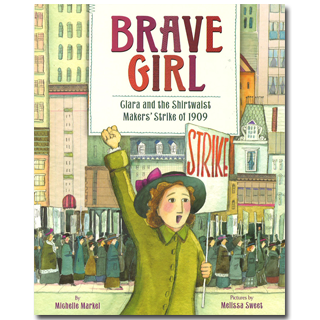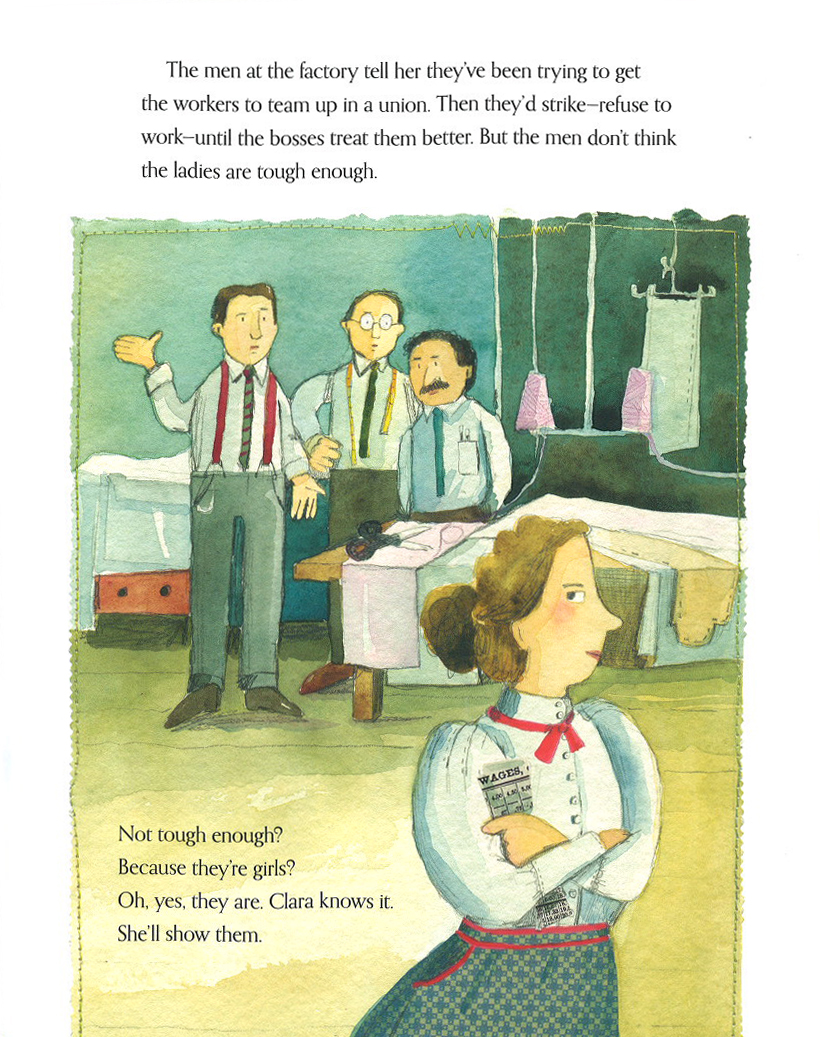
A FEW OTHER EVENTS FOR
MARCH 28:
- Happy birthday Byrd Baylor (Everybody Needs a Rock), Steven Lindblom (How to Build a Robot), and Doreen Cronin (Clack, Clack, Moo).
- On this day in 1930 the name of Turkey’s largest city, Constantinople, is officially changed to Istanbul, though it had been called Istanbul since 1453 when a conquering Ottoman sultan gave it the moniker based on a Greek Phrase meaning “the city.” Read Leyla: The Black Tulip by Alev Lytle Croutier, illustrated by Kazuhiko Sano.
- In 1941, writer Virginia Woolf fills her pockets with stones, walks into a river and drowns. Read Nurse Lugton’s Curtain by Virginia Woolf, illustrated by Julie Vivas.
Today marks the birthday of Clara Lemlich, born in 1886 in Ukraine to a Jewish family. Following a pogrom in 1903, Clara and her family immigrated to the United States. She stood a mere five feet tall, but as Brave Girl, our book of the day, tells us, she had grit and was going to prove it.
No one will hire Clara’s father; so to support her family this intrepid teenager goes to work in the garment industry, carrying her own sewing machine each day. That industry has set up harsh rules for workers—a few minutes late means losing a half days pay, and a girl can be fired for pricking a finger and bleeding on the cloth. Working by day and going to school at night so she could learn English, Clara tries to make her way in the world. But as she begins to understand what is happening in the workplace, Clara finds herself smoldering with anger over the treatment of the women. She becomes an organizer of pickets and strikes; she’s arrested seventeen times and has six broken ribs to prove it. Then in 1909, Clara helps women organize the largest walkout of women workers in the history of the United States.
Melissa Sweet, one of our most accomplished illustrators for nonfiction picture books today, brings Clara and her fellow workers to life. As they decide to go on strike, the illustration shows them raising one arm in solidarity as Clara addresses her fellow workers in Yiddish. In these illustrations Clara has been made an appealing and sympathetic heroine, a girl that young readers can identify with and emulate. In the end Clara proves that in America, “wrongs can be righted, warriors can wear skirts and blouses, and the bravest hearts may beat in girls only five feet tall.”
An endnote provides background for these events; this book will send both adults and students out to gather more material about the garment industry and the strike. Clara, by the way, lived to be 96, had two husbands and three children, and even helped organize the staff of her nursing home in later years.
For those hunting for exciting new subjects for Women’s History Month, you need to go no further than Clara and her fellow women strikers in 1909. With questions about unions in the headlines today, I am grateful for this book that not only tells Clara’s story but also explains why workers had to fight for their rights in the 1900s. It helps explain to young readers that classic bumper sticker: “The Labor Movement: The Folks Who Brought You the Weekend.”
Here’s a page from Brave Girl:
Originally posted March 28, 2013. Updated for .







Thank you for sharing this important and inspirational story.
I had heard about Brave Girl and after reading your review here, I requested a copy from the library. I just received notice that it’s on my hold shelf. I can’t wait to read it. Working conditions and factory safety issues still are relevant today. I loved the story you shared about Clara organizing the staff of her nursing home. I can just picture it.
Ever since I read Uprising by Margaret Peterson Haddix, I’ve been interested in the history of the Triangle shirtwaist factory disaster. Ms. Haddix provides a includes bibliographical references at the end of her book.
For others interested and wanting to read more books on this subject, Lelia at Bookshelves of Doom wrote a post listing books elated to the Triangle Shirtwaist Fire. http://bookshelvesofdoom.blogs.com/bookshelves_of_doom/2013/03/march-25-1911-the-triangle-shirtwaist-fire.html#comments
That looks interesting, I’ve added it to my wishlist. Especially since my grandmother worked in a glove factory in Chicago many moons ago. Just discovered this website and have favorited it.
For women’s history month I read this to my 4th grade classes and recommended it to my other library colleagues. The illustrations are fantastic, colorful and upbeat and never dreary. I am impressed that it tells the history accurately, but in terms children can deal with. It is just enough to get the kids really fired up without getting too “preachy”. Many of my students are working class and immigrant families. I believe it struck a chord. The illustrations are fantastic, especially the depiction of the factory floor. They loved it!
My mother, Fannie Greenberg Atlas came from the Ukraine to St. Louis ..She was 14 and immediately went to work in a garment factory, They could not leave until allowed to go to the bathroom, and had to furnish their own toilet paper. They ate at the machine where she was a finisher. She began making speeches about equality and justice, was arrested when the girls finally went on strike.. In 1910 ,mother was one of two women elected to THE FIRSTT JOINT BOARD.OF THE INTERNATIONAL LADIES GARMENT WORKERS, a great union.. She supported dance, drama, and music for children of workers, supported African Americans getting into Local 104,and finally was given a LIFE membership AWARD IN 1960. SHE LEFT A LEGACY FOR ME, MY CHILDREN, AND MY grandchildren. I LOOK FORWARD TO GETTING THIS BOOK.